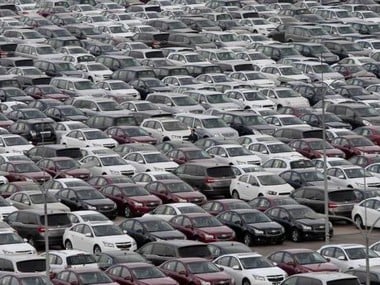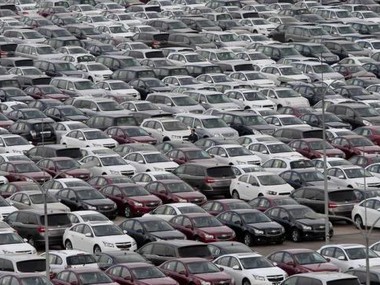Everyone was expecting a downslide in the first quarter Gross Domestic Product (GDP) numbers but at 5 percent in the April-June quarter, the numbers have come as a shocker. With this, for two consecutive quarters, India’s GDP growth has gone below 6 percent. The corresponding gross value added (GVA) figure for the June quarter was at 4.9 percent. At 5 percent, the GDP numbers are the lowest in six years.
The growth scenario, for a country dreaming of a $5 trillion economy, couldn’t have come at a worse time than this. Such a decline in national income also validates the recent warnings issued by NITI Aayog and the Monetary Policy Committee (MPC) on the worsening growth scenario.
In fact, Q1 GDP numbers have only reflected what macro numbers have been indicating over the last several months. Demand has collapsed across segments, real estate and construction sectors have been showing dismal activity. FMCG companies have been reporting declining sales and
automakers
dealing across product segments have been cutting production due to low demand, in turn, leading to job losses. Both NBFCs and commercial banks have been restricting their credit operations on account of high bad loans and liquidity constraints post-the IL&FS fiasco. Practically, there were no positive cues anywhere to rely on. This was bound to reflect on the GDP numbers. GDP internals Looking closely at the GDP figures, the big disappointment is the manufacturing sector. It grew at just 0.6 percent barely escaping the negative growth zone as against a growth of 12.1 percent over the year-ago quarter. This is the real problem area because manufacturing is the backbone of the economy and directly connects to employment. In the previous quarter, the growth was at 3.1 percent. [caption id=“attachment_5622651” align=“alignleft” width=“380”]
 Representational image. Reuters[/caption] Growth in private consumption has declined to 3.1 percent from 7.2 percent in the previous quarter, while growth in government consumption fell to 8.8 percent from 13.1 percent over last quarter. However, growth in the Gross Fixed Capital Formation (GFCF), a key indicator of overall investment activity, was marginally up at 4 percent compared with 3.6 percent in the previous quarter. The numbers are a clear message to the government that it needs to now approach structural reforms moving on from incremental reforms. These should include privatisation of PSUs, freeing up of capital and bringing in private investments, revamping land and labour laws, unclogging the tax laws further and giving investment boost to infrastructure and housing sectors. Reform intent The good thing is that there is a clear intent and willingness on the part of the government to bring in reforms in the economy and address the problem areas. Just before the GDP data release, Finance Minister Nirmala Sitharaman announced government’s decision to
amalgamate 10 nationalised banks
into four clubbing them with bigger bank in respective groups, marking the biggest bank merger exercise since
Bank of Baroda
, Vijaya Bank and Dena Bank. A few days back, a series of measures were announced to ease Foreign Direct Investment (FDI) rules across segments. The government opened up or
eased FDI rules
in four sectors—100 percent FDI in coal mining, contract manufacturing and insurance intermediaries under automatic route and 26 percent FDI in digital media after government approval. The Reserve Bank of India (RBI)
annual report
, released yesterday, had acknowledged the challenges on the growth front. The central bank said lack of domestic demand is impacting ‘animal spirits’ in the economy and stressed the need to urgently focus on reviving private investments and consumption. The annual report has pegged the FY20 growth at 6.9 percent, with growth likely to remain in the range of 5.8-6.6 percent in the first half and thereafter likely to pick up to 7.3-7.5 percent in the second half. By doing so, the RBI was showing a mirror to the government about the actual state of the economy and pointing out where the problem lies. The GDP numbers released on Friday confirm that the RBI warnings were timely. What now? The economy needs a strong stimulus—both on the monetary and fiscal side. The MPC has done its part by cutting the repo rate, at which it lends short-term funds to banks, by 35 bps in its August policy. That was unprecedented. One bps is one-hundredth of a percentage point. A 35 bps cut is something that has never happened in the past. With this, the repo rate at which the RBI lends to banks is at the lowest rate in nine years. It even indicated a willingness to follow up with more rate cuts. “Even as past rate cuts are being gradually transmitted to the real economy, the benign inflation outlook provides headroom for policy action to close the negative output gap,” the MPC said in the policy document. But, it was also a way of telling the government that the central bank has done its part and the government needs to follow up.
Representational image. Reuters[/caption] Growth in private consumption has declined to 3.1 percent from 7.2 percent in the previous quarter, while growth in government consumption fell to 8.8 percent from 13.1 percent over last quarter. However, growth in the Gross Fixed Capital Formation (GFCF), a key indicator of overall investment activity, was marginally up at 4 percent compared with 3.6 percent in the previous quarter. The numbers are a clear message to the government that it needs to now approach structural reforms moving on from incremental reforms. These should include privatisation of PSUs, freeing up of capital and bringing in private investments, revamping land and labour laws, unclogging the tax laws further and giving investment boost to infrastructure and housing sectors. Reform intent The good thing is that there is a clear intent and willingness on the part of the government to bring in reforms in the economy and address the problem areas. Just before the GDP data release, Finance Minister Nirmala Sitharaman announced government’s decision to
amalgamate 10 nationalised banks
into four clubbing them with bigger bank in respective groups, marking the biggest bank merger exercise since
Bank of Baroda
, Vijaya Bank and Dena Bank. A few days back, a series of measures were announced to ease Foreign Direct Investment (FDI) rules across segments. The government opened up or
eased FDI rules
in four sectors—100 percent FDI in coal mining, contract manufacturing and insurance intermediaries under automatic route and 26 percent FDI in digital media after government approval. The Reserve Bank of India (RBI)
annual report
, released yesterday, had acknowledged the challenges on the growth front. The central bank said lack of domestic demand is impacting ‘animal spirits’ in the economy and stressed the need to urgently focus on reviving private investments and consumption. The annual report has pegged the FY20 growth at 6.9 percent, with growth likely to remain in the range of 5.8-6.6 percent in the first half and thereafter likely to pick up to 7.3-7.5 percent in the second half. By doing so, the RBI was showing a mirror to the government about the actual state of the economy and pointing out where the problem lies. The GDP numbers released on Friday confirm that the RBI warnings were timely. What now? The economy needs a strong stimulus—both on the monetary and fiscal side. The MPC has done its part by cutting the repo rate, at which it lends short-term funds to banks, by 35 bps in its August policy. That was unprecedented. One bps is one-hundredth of a percentage point. A 35 bps cut is something that has never happened in the past. With this, the repo rate at which the RBI lends to banks is at the lowest rate in nine years. It even indicated a willingness to follow up with more rate cuts. “Even as past rate cuts are being gradually transmitted to the real economy, the benign inflation outlook provides headroom for policy action to close the negative output gap,” the MPC said in the policy document. But, it was also a way of telling the government that the central bank has done its part and the government needs to follow up.
)